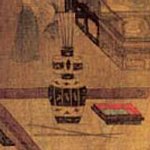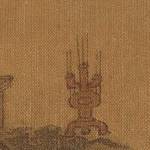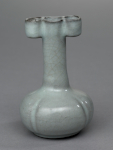Medieval Baltic


Games and Pastimes
Tuho (투호, 投壺)
Tuho, or 'Pitch-pot,' (also Mandarin Chinese touhu, Japanese tōko/とうこ) is a game with a long history, both in China and Korea. The Commentary of Zuo (左傳), compiled before 389 BCE, mentioned a game of pitch-pot played by nobles in 530 BCE (Rudolph, 1950). The first century BCE Records of the Grand Historian (史記) also mentions the party game (ibid.). The Classic of Rites (禮記), that described rites in use in the Zhou Dynasty (ca. 1050-256 BCE) was later edited during the Han dynasty (202 BCE. - 220 CE) of China, and has a detailed chapter describing the game. According to Rudolph (1950), the rules below were inserted during the later revision.
According to the rules for Pitch-pot....
The number of the counters varies according to the place in which they kneel when playing the game. Each round is with 4 arrows. If the game is played in the chamber, there are 5 sets of these; if in the hall, 7; if in the courtyard, 9. The counters are 1 cubit 2 inches long. The neck of the pot is 7 inches long; its belly, 5; and its mouth is 2½ inches in diameter. It contains a peck and 5 pints. It is filled with small beans, to prevent the arrows from leaping out. It is distant from the mats of the players, the length of 2½ arrows. The arrows are made of mulberry wood, or from the zizyphus, without the bark being removed....
Excerpts of The Game of Pitch Pot, Legge (1885).
The Classic of Rites appears to have then become the standard reference for playing the game (Rudolph, 1950, Lee and Park, 2006).
The earliest reference to tuho being played on the Korean peninsula is during the Gorguryeo Kingdom (37 BCE - 668 CE), where it is mentioned in the History of Old Tang (舊唐書) (Lee and Park, 2006) and the 81st Book of Sui (隋書)(Wen, 2003). It appears it fell out of fashion for a while, as King Yejong of Goryeo (r. 1105-1122 CE) received a tuho set from the Sung Emperor in 1116 CE and was curious about how it was played (Lee and Park, 2006). Soon the whims of fashion changed again and it was not until the Joseon Dynasty that it was promoted as a Confucian activity. This game was played by both women and men, including royalty such as Prince Yangnyong (양녕대군, 讓寧大君. 1394-1462) with the princesses, and King Hyeonjong of Joseon (현종, 顯宗. 1641-1674) with the Queen Mother, Queen, Grand Prince, princes and princesses (Lee and Park, 2006).
Playing Pieces
The Pot
The earliest extant ceramic pitch pot, from the Western Han Dynasty (206 BCE – 9 CE) was discovered in 1969, in the eastern Chinese city of Jiyuan (濟源, 济源)(Wen, 2003). It was 26.6 cm high, with a 13 cm high neck, and a mouth diameter of 4 cm (ibid.). The innovation of extra 'ears' that arrows could be tossed into, appears to date from the 3rd century at the earliest (Rudolph, 1950), and the 8th century at the latest (Inokuchi, 2004). The Shōsōin Treasure House of Nara, Japan, includes in its' collection a bronze pot with two cylinders (Inokuchi, 2004), as does a later Song Dynasty half-sized porcelain vase at the Cleveland Museum of Art (Accession Number:1957.65), and images of Southern Tang dynasty artwork. As the re-introduction of tuho into Korea occurred in the 12th century, it is extremely likely that the 'eared' pots were also introduced at this time.
Top: Tuho players from a Han Dynasty tile. 3rd century at the latest. After Rudolph (1950) and the Hong Kong Heritage Museum (2006).
Centre Left:Tuho pot in the background of "重屏会棋图", Southern Tang period. From Wikipedia.
Centre Right: Gathering of Government-Officials, ca. 1551, Joseon Dynasty Korea. The Metropolitan Museum of Art, Accession Number: 2008.55.
Bottom Left: Guan ware arrow-holder vase, Southern Song dynasty (1127-1279). The Cleveland Museum of Art, Gift of Mr. and Mrs. Severance A. Millikin 1957.65
Bottom Right: Joseon Dynasty tuho pot and arrows. After the Dosanseowon Site
The tuho pot kept at the Dosan Confucian Academy (Dosanseowon, 도산서원, 陶山書院) traditionally is believed to have belonged to academy founder Yi Hwang (1501-1570), who was an avid player (Lee and Park, 2006; 83). It is treated as a relic, and is so well known it appeared on the 1000 Won banknote in South Korea along with Yi's portrait until 2005. It is remarkably similar to the pot depicted in the Met Museum's "Gathering of Government-Officials", the only major differences being the three-footed stand, and the narrow bottom of the pot - perhaps the feet were needed for stability during arrow tosses?
The apogee of pot complexity possibly occurred in Ming and Qing Dynasty China, where at least one extant jar has an additional eight cylinders one could toss arrows inside (Frankel, 2004)! Jones (1990; 103) notes that by this stage the vases 'are so heavily encrusted with figures and short tubes that it is unlikely they could have been used' for playing tuho, instead, they were more likely for decoration that reminded viewers of its' long history. The Dosan Confucian Academy pot is only generically dated to the Joseon Dynasty, which may indicate that in Korea the vase remained relatively unchanged until the 20th century.
The Arrows
In 1984 in Yongzhou (永州, was Lingling 零陵), in southern China, another Western Han period tomb was discovered containing an earless tuho pot with bamboo arrows inside (Wen, 2003). They were cut in a square cross-section, until the final 6 cm of the shaft when tapered into a circular, 1.5-2 mm stick (ibid.). The length of the arrows themselves varied from 18 cm to 25.8 cm (ibid.). Extant arrows are also found amongst the relics at Dosanseowon (Dosanseowon 2010), and with Shōsōin Treasure House pot. The arrows at Shōsōin appear to be fletched and are weighted at one end (Wen, 2003).
Left: Yongzhou tuho pot with arrows. After Wen (2003).
Right: Shōsōin toko pot and arrows. Not to scale, and top and bottom halves of arrows may not match. After Wen (2003) and Inokuchi (2004).
Tuho was also a popular drinking game. For every arrow that missed the pot, the loser (called bulseung (lit. no-success, 불승, 不承.) had to take a drink of wine. To prevent betting and gambling on the outcome, losers could opt to sing a song as penalty, instead (Lee and Park, 2006). People who didn't miss their mark were called hyeon (lit. wise, 현). Whether you are drinking or not, it is still an enjoyable game to play. Try it out!
Bibliography
- Cleveland Museum of Art. 2008. Arrow Holder Vase: Guan ware
Website last accessed: 23rd September, 2022. - Dosanseowon Museum: Remains Info: Tuho
Website last accessed: 3rd January, 2010. - Frankel, E. 2004. Play It Again: Arrow Tossing Vase
Website last accessed: 3rd January, 2010. - Hong Kong Heritage Museum. 2006. Enlightening Trivialities - Ancient Chinese Pastimes Exhibition.
Website last accessed: 23rd September, 2022. - Inokuchi, Y. 2004. Utopian Imagery in the Treasures of the Shosoin: Visions of Immortality in Nara-Period Japan Bulletin of Office of the Shosoin Treasure House 26; 1-12
井口喜晴 "正倉院宝物にみる神仙世界 −天平人の桃源" 倉院紀要 第26号; 1-12.
Available online. PDF. - Jones, M., [ed.] 1990. Fake? The Art of Deception (Berkeley and Los Angeles: University of California Press)
- Lee E-W. and Park J-H. [trans.] 2006. Korea's Pastimes and Customs: A Social History (Panamus, New Jersey: Homa & Sekey Books)
- Legge, J. [trans.] 1885. The Lî Kî (Oxford: Clarendon Press)
Available online at Sacred Texts - Rudolf, R.C. 1950. The Antiquity of T'ou Hu Antiquity 24; 175-8.
- Wen, To-Pin. 2003. The Research of Tou Hu from the Han Dynasty to the SuiTangWudai (BC 206 - AD 960) Journal of National Taitung Teachers College 14(1); 267-294.
文多斌. 2003. 兩漢三國至隋唐五代時期的投壺 (BC 206 - AD 960) 台東師院學報 民92,14 期(上);,267 ~ 294 頁
Formerly available online at the National Taitung Teachers College.







